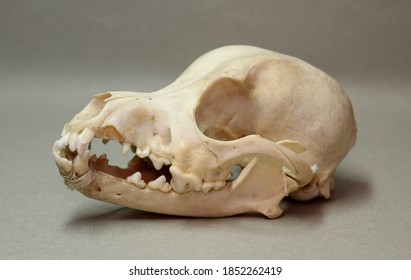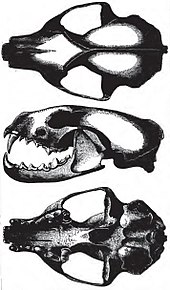70 Deer Animal Teeth Identification Chart
The end of winter is a peak period of mortality for many species and skulls can be found virtually anywhere but skull identification can be difficult. Spring is a good time to look for mammal skulls.
Determining which teeth are present in the jawbone and how worn those teeth are.

Deer animal teeth identification chart. Behind the incisors there is a significant gap lacking any teeth then finally a row of similar looking molars for grinding vegetation. Upper molar dumbbell-shaped Fig. Deer teeth in Fig.
Individual teeth designated with upper case letters for upper teeth and lower case letters for lower teeth eg. The only native North American deer that has canine teeth is the elk. Animal Skulls has very.
The iron deposits serve to harden the. You can distinguish them from a carnivore from their molars. An Introductory Guide to Methods of Identification.
Typically the deer has 4 cheek teeth if it is 5 to 6 months old and 5 cheek teeth if the deer is 7 months to one year old. Webbed short feet for swimming. Animal Skull ID.
Many non-human animals have different dental formulas compared to. Yearlings can be identified by looking at the replacement of the temporary tricuspid third tooth with a permanent bicuspid tooth. The Barbary deer are also the only deer species to be found in Africa and are only found in North Africa around the Atlas Mountains.
2002 Mammal Bones and Teeth. Teeth Human Animal Omnivorous Carnivorous Herbivorous Omnivorous. Lives in streams ponds.
Premolars 23 or 333 3. 5 upper cheek teeth per side. Auditory bulla prominent elongated4 3.
Deer pronghorn bighorn sheep mountain goats bison and musk ox all lack upper incisors. 4 upper cheek teeth per side. P3 is upper premolar 3 m2 is lower molar 2.
Yearlings and older deer will have 6 cheek teeth. Horns Members of the deer family which includes caribou deer elk and moose have antlers. The shrew in our area is Trowbridges Shrew.
These are some really nice books that will aid in skull identification. With the help of a guide you can identify exactly what animal you hold in your hands. There are in total 10 subspecies of red deer each varying slightly in coloration physiology and geography and so is quite a diverse group but not so diverse that you wouldnt know a.
Identifying Animal Skulls By Their Teeth Canine skull with clear carnassial and canine teeth Photo. They have all four types of teeth. Animal species based on their post-cranial morphology can similarly befound in.
Figure 1 depicts the general anatomy of the molars in a deers lower jaw. This beginners guide to animal bone identification has been written by Chris Faine and is one of a series of introductory guides published by the community archaeology network Jigsaw. This guide provides some of the basics to help field practitioners with identification.
Thats some set of choppers. Animal bone is one of if not the most commonly recovered finds material from archaeological sites. And if you were to only have the fossilized teeth of these creatures we could still construct a classification nearly identical to the one we have now which is based on all anatomical features.
Its going to take a harvest to determine a deers age with this method so if you dont shoot and kill the thing first its tough to get an exact deer age. You can tell a lot from a smile. Deer order Artiodactyla mule deer.
White rump patch with short darker tail. The subspecies of red deer. How to identify mammal skulls.
In my previous post about animal skulls I provided you with some basic animal skull identification resources but in this post I want to help you begin to narrow down what type of animal skull you might have found. Bighorn Sheep Dark brown to gray coloring. These can be seen in.
Premolars and molars are located along the side of. Because plants are often difficult to break down an herbivores molars are flatter and wider for grinding food and aiding in digestion. The incisors are the teeth in the front of a deers mouth.
Animals that only consume plants are called herbivores and include elephants sheep deer giraffes kangaroos beavers and more. Determining a Dental Formula. Now were betting most deer in your area wouldnt sit back in a dentist chair open wide and let you peer into their gullet to count molars.
There are roughly 5000 species placed in 26 orders. The enamel of the tips of their teeth is reddish due to iron pigment. Teeth are one of the distinguishing characteristics of class Mammalia.
Identifying the full range of species that you could potentially find. These animals consume both plants and animals. Figure 2 depicts the jawbone of a healthy adult white-tailed deer.
If you find a small skull without a diastema and with red-tipped teeth you have the skull of a shrew. Incisors 33 Canines 11 Premolars 44 Molars 23 OR 33 11 44 23 2 42. So varied are.
You have to check a deers teeth. With teeth of the two species particularly molars being very different. Breeding in deer Antlers vs.
25 Wildlife Skull Small Animal Skull Identification Chart
A Guide to North American Species Mark Elbroch 31. Enjoy learning about wildlife.

Animal Jaw Bone High Res Stock Images Shutterstock
Skull over 300mm 1 foot long.

Wildlife skull small animal skull identification chart. A few relatively simple observations of an animals skull can tell us what the animal ate whether the animal was predator or prey and which senses were most important to the animals survival. North American Animal Skull Identification Resources to Help You Identify Found Skulls Deer and Animal Skulls. An Exploration of Alan Dudleys Curious Collection Skulls is a beautiful spellbinding exploration of more than 300 different animal skullsamphibians birds fish mammals and reptileswritten by New York Times bestselling author.
Peterson Field Guide to Animal Tracks A Key-Guide to Mammal Skulls and Lower Jaws Audubon Society Pocket Guide to Mammals. Skull relatively small greatest length. Southern short-tailed shrew Blarina carolinensis 1.
Animal Skulls has very nice illustrations and pictures of skulls while Skulls and Bones is an excellent. Skulls Unlimited carries several levels of key guides from simple to advanced. By Mark Elbroch November 2006 This uniquely thorough reference and guidebook offers illustrations descriptions and measurements for the skulls of some 275 animal species found throughout North America.
Badger skulls are slightly shorter than a foxs at around 13cms long. Greatest length of skull less than 76 mm5 5. Were you able to identify which animal it belonged to.
Smaller than most other rodent skulls generally less than 25 mm. There full body is around 17-22cms in length. Bones feathers and fur are all eaten.
Its a great place to start and a small enough size to be portable. Eastern fox squirrel 5. THE LITTLE GUYS 2 12 3 4.
A skull key can be a valuable teaching aid in the classroom. In my previous post about animal skulls I provided you with some basic animal skull identification resources but in this post I want to help you begin to narrow down what type of animal skull you might have found. Dark pigmented enamel on teeth.
Greatest length of skull greater than 76 mmGroundhog 4. Same angled front teeth as Rattus. If you find a small skull without a diastema and with red-tipped teeth you have the skull of a shrew.
Below one will find skeleton replicas of some of our smaller mammals. To create a wishlist use the next to an item to add it. Jaguar Panthera onca Skull relatively large greatest length.
3 PURDUE EXTENSION WILDLIFE SCIENCE 1. A KEY GUIDE OT MAMMAL SKULLS AND LOWER JAWS by Aryan Roest Large skull over 150 mm 6 long Medium skull 75-150 mm 3-6 inches long Small skull 25-75 mm 1-3 inches long Tiny skull. And other small animals.
The 4-H Wildlife Science curriculum is for youth who. NOTE TO 4-H MEMBER. Fox skulls have long narrow snouts and are around 14cms in length.
The iron deposits serve to harden the enamel and are concentrated in those parts of the teeth most subject to wear coyote. Nasal profile concave elongate canines with grooves broad frontal with dip. For a more complete animal skull identification guide we highly recommend the following books.
The enamel of the tips of their teeth is reddish due to iron pigment. They are not a threat to healthy grown deer. Identifying Animal Skulls By Their Teeth Canine skull with clear carnassial and canine teeth Photo.
Animal Skulls is a unique reference and identification guide to skulls of 275 vertebrate species of North America. Skull less than 300mm long. Indiana Deptartment of Natural Resources.
These are some really nice books that will aid in skull identification. No outer ridge around eye sockets. Weasels have long skulls with large eye sockets.
I would typically recommend this book for intermediate to advanced readers but it could also. Location of the orbits or eye sockets-. Larger animals are torn into pieces by its sharp hooklike beak.
A Guide to North American Species. Here are a few skulls for you to study. Animal Skull ID.
Triangular shaped skull pointed towards the front. Zygomatic archcurved bones forming arch along side of skullcheekbones Skull Size. U-shaped temporal ridges form a small sagittal crest Fig.
Was it a Predator or Prey Species. With the help of a guide you can identify exactly what animal you hold in your hands. Have you ever found a skull in the woods or weeds.
It can swallow whole rats mice and small birds. The shrew in our area is Trowbridges Shrew. Nasal profile concave large robust conical upper and lower canines more circular than elliptical in cross-.
Mammals are one of the most diverse classes of animals in the world with an enormous range in size dietary preference and behavior.

